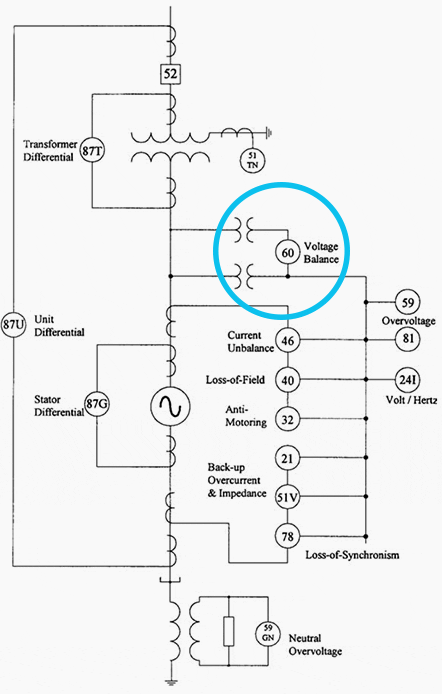
Voltage Imbalance Protection of Synchronous Generator (ANSI Code 60)
Synchronous Generator Protection
In an apparatus protection perspective, generators constitute a special class of power network equipment because faults are very rare, but can be highly destructive and therefore very costly when they occur. If for most utilities, generation integrity must be preserved by avoiding erroneous tripping, removing a generator in case of a serious fault is also a primary if not an absolute requirement.
Furthermore, protection has to be provided for out-of-range operation normally not found in other types of equipment such as overvoltage, overexcitation, limited frequency or speed range, etc.

Figure 0 – Typical generator-transformer protection scheme
Table below provides a list of protective relays and their functions most commonly found in generator protection schemes. These relays are implemented as shown on the single-line diagram of Figure 0 above. .
As shown in the Relay Type column, most protective relays found in generator protection schemes are not specific to this type of equipment but are more generic types.
| ANSI | Function Description | Relay Type |
| 87G | Generator phase phase windings protection | Differential protection |
| 87T | Step-up transformer differential protection | Differential protection |
| 87U | Combined differential transformer and generator protection | Differential protection |
| 40 | Protection against the loss of field voltage or current supply | Offset mho relay |
| 46 | Protection against current imbalance. Measurement of phase negative sequence current | Time-overcurrent relay |
| 32 | Anti-motoring protection | Reverse-power relay |
| 24 | Overexcitation protection | Volt/Hertz relay |
| 59 | Phase overvoltage protection | Overvoltage relay |
| 60 | Detection of blown voltage transformer fuses | Voltage balance relay |
| 81 | Under- and overfrequency protection | Frequency relays |
| 51V | Backup protection against system faults | Voltage controlled or voltage-restrained time overcurrent relay |
| 21 | Backup protection against system faults | Distance relay |
| 78 | Protection against loss of synchronization | Combination of offset mho and blinders |
Now, let’s have an overview of specific protection ANSI 60 – Detection of blown voltage transformer fuses.
Loss of a voltage phase signal
The loss of a voltage phase signal can be due to a number of causes. The primary cause for this nuisance is a blown-out fuse in the voltage transformer circuit. Other causes can be a wiring error, a voltage transformer failure, a contact opening, a misoperation during maintenance, etc.
Since the purpose of these VTs is to provide voltage signals to the protective relays and the voltage regulator, the immediate effect of a loss of VT signal will be the possible misoperation of some protective relays and the cause for generator overexcitation by the voltage regulator.
Among the protective relays to be impacted by the loss of VT signal are:
- Function 21 – Distance relay. Backup for system and generator zone phase faults.
- Function 32 – Reverse power relay. Anti-motoring function, sequential tripping and inadvertent energization functions.
- Function 40 – Loss-of-field protection.
- Function 51V – Voltage-restrained time overcurrent relay.
Normally these functions should be blocked if a condition of fuse failure is detected.
Therefore, the most common practice for loss of VT signals detection is to use a voltage balance relay as shown in Figure 1 on each pair of secondary phase voltage. When a fuse blows, the voltage relationship becomes imbalanced and the relay operates. Typically, the voltage imbalance will be set at around 15%.

Figure 1 – Example of voltage balance relay
When a situation of loss of one or more of the VT signals occurs, the following conditions develop:
- There will be a drop in the positive sequence voltage accompanied by an increase in the negative sequence voltage magnitude. The magnitude of this drop will depend upon the number of phases impacted by a fuse failure.
- In case of a loss of VT signal and contrary to a fault condition, there should not be any change in the current’s magnitudes and phases. Therefore, the negative and zero sequence currents should remain below a small tolerance value. A fault condition can be distinguished from a loss of VT signal by monitoring the changes in the positive and negative current levels. In case of a loss of VT signals, these changes should remain below a small tolerance level.
All the above conditions can be incorporated into a complex logic scheme to determine if indeed a there has been a condition of loss of VT signal or a fault.

Figure 2 – Symmetrical component implementation of fuse failure detection
Figure 2 represents the logic implementation of a voltage transformer single and double fuse failure based on symmetrical components.
If the following conditions are met in the same time (and condition) during a time delay longer than T1:
- The positive sequence voltage is below a voltage set-value SET_1,
- The negative sequence voltage is above a voltage set-value SET_2,
- There exists a small value of current such that the positive sequence current I1 is above a small set-value SET_4 and the negative and zero sequence currents I2 and I2 do not exceed a small set- value SET_3,
then a fuse failure condition will pick up to one and remain in that state thanks to the latch effect. Fuse failure of a specific phase can be detected by monitoring the level voltage of each phase and comparing it to a set-value SET_5. As soon as the positive sequence voltage returns to a value greater than the set- value SET_1 and the negative sequence voltage disappears, the fuse failure condition returns to a zero state.
Reference: The electric power engineering handbook – L.L. Grigsby (Purchase hardcover book from Amazon)